Morning Eye Candy: Back to Our Roots
Posted in Photography on March 26 2014, by Matt Newman
In the Ross Conifer Arboretum – Photo by Ivo M. Vermeulen

Inside The New York Botanical Garden
Posted in Photography on March 26 2014, by Matt Newman
In the Ross Conifer Arboretum – Photo by Ivo M. Vermeulen
Posted in Adult Education on March 25 2014, by Leda Meredith
Leda Meredith is the Gardening Coordinator for Adult Education
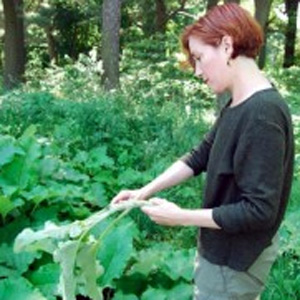 After months of an especially relentless winter, spring is officially here! It’s not only the time when sunshine and blossoms beckon, but also when we need to get busy in the garden. The gardening you do now will determine the success of your landscape through summer and even into fall. Tasks to tackle can include anything from preparing your soil for the coming year to making the leap toward designing a pollinator-friendly garden. For those of you more concerned with indoor plants, it might be time to think about a spring repotting!
After months of an especially relentless winter, spring is officially here! It’s not only the time when sunshine and blossoms beckon, but also when we need to get busy in the garden. The gardening you do now will determine the success of your landscape through summer and even into fall. Tasks to tackle can include anything from preparing your soil for the coming year to making the leap toward designing a pollinator-friendly garden. For those of you more concerned with indoor plants, it might be time to think about a spring repotting!
Whatever your focus, NYBG’s Adult Education courses offer you plenty of opportunities to become a better gardener. They might even give you the confidence to try something entirely new in your home garden. Here are my picks for the classes that will give you the skills you need for your best gardening year ever:
Posted in People on March 25 2014, by Sonia Uyterhoeven
Sonia Uyterhoeven is the NYBG’s Gardener for Public Education.
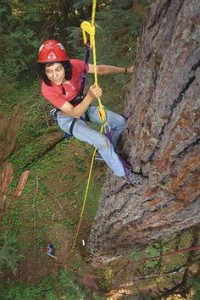 While attending New England Grows—a regional tradeshow and educational forum that takes place in Boston each year—I was lucky enough to hear the ecologist and public spokesperson, Nalini Nadkarni, give a lecture on rain forest ecology and its importance as a biological system.
While attending New England Grows—a regional tradeshow and educational forum that takes place in Boston each year—I was lucky enough to hear the ecologist and public spokesperson, Nalini Nadkarni, give a lecture on rain forest ecology and its importance as a biological system.
Dr. Nadkarni’s research was not conducted on the forest floor, but rather at great heights above it. She quite literally harnessed the tools of the arborist’s trade and hoisted herself and a team of researchers 100 feet up in the air to explore the biological communities that thrived in the upper layers of the rain forest’s canopy.
Up in the treetops, Nadkarni and her team found a surprising diversity. The plants they came upon were expected: orchids, bromeliads, ferns, mosses, and lichens. These epiphytic plants are an important component of tropical arboreal communities, surviving and thriving by collecting water and nutrients from rainfall trapped in their foliage. What surprised the researchers, however, was the complexity of the arboreal ecosystem.
Posted in Photography on March 25 2014, by Matt Newman
If I didn’t know any better, I’d say Tiffany’s might have taken some inspiration from the blue-green seafoam of one of our favorite species (and rightfully so). See it now in the aquatic plant house of the Conservatory—it won’t be swirling its colorful skirts forever.
The jade vine (Strongylodon macrobotrys) in the Enid A. Haupt Conservatory – Photo by Ivo M. Vermeulen
Posted in What's Beautiful Now on March 24 2014, by Lansing Moore
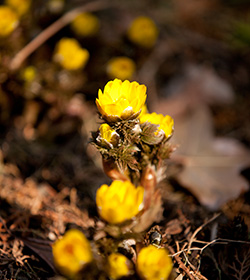 With such wild changes in temperature, this year’s crop of early spring blooms is a hearty bunch indeed. The Garden party is already getting started in the Jane Watson Irwin Perennial Garden, whose enthusiastic residents are always some of the first to rise from their slumber.
With such wild changes in temperature, this year’s crop of early spring blooms is a hearty bunch indeed. The Garden party is already getting started in the Jane Watson Irwin Perennial Garden, whose enthusiastic residents are always some of the first to rise from their slumber.
The vibrant ‘Arnold Promise’ witch-hazel (Hamamelis × intermedia) is blooming alongside the snowdrops (Galanthus) and winter aconite (Eranthis hyemalis). The Ladies’ Border is also lovely at the moment, with Amur adonis (Adonis amurensis) in bloom and both the paper bush flowers (Edgeworthia chrysantha) and viburnum (Viburnum × bodnantense ‘Dawn’) in bud.
For serene shades of white and violet, stop by Wamsler Rock to see more snowdrops alongside the early crocus (Crocus tommasinianus). Click through for some gorgeous close-ups of those intrepid blooms that herald the long-awaited spring!
Posted in Photography on March 24 2014, by Matt Newman
In the Enid A. Haupt Conservatory – Photo by Ivo M. Vermeulen
Posted in Photography on March 23 2014, by Matt Newman
The Viburnum is giving us a peek at future spring color in the Ladies’ Border, joining the crocuses, Adonis, and other early season go-getters as a reminder that the new season really has kicked off.
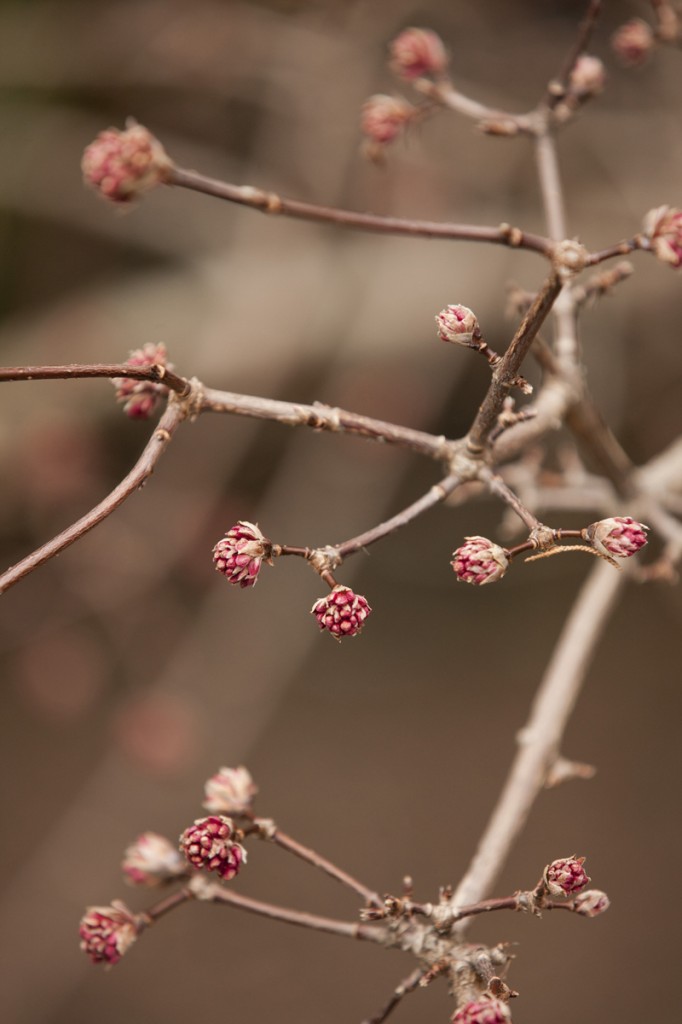
Viburnum × bodnantense ‘Dawn’ in the Ladies’ Border – Photo by Ivo M. Vermeulen
Posted in Photography on March 22 2014, by Matt Newman
In the Enid A. Haupt Conservatory – Photo by Ivo M. Vermeulen
Posted in Programs and Events on March 21 2014, by Lansing Moore
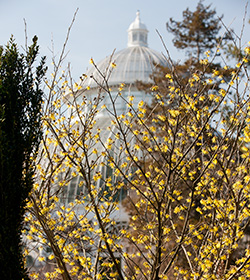 Spring has sprung, and this weekend we are debuting new tours dedicated to exploring early spring at the Garden! More and more green shoots are sprouting each day and we have a beautiful, sunny weekend in store with plenty of programs to take advantage of it.
Spring has sprung, and this weekend we are debuting new tours dedicated to exploring early spring at the Garden! More and more green shoots are sprouting each day and we have a beautiful, sunny weekend in store with plenty of programs to take advantage of it.
In the Enid A. Haupt Conservatory, The Orchid Show: Key West Contemporary continues to provide tropical adventure with an Orchid Evening as well as Escape to Paradise: The Music of Key West this weekend. Check out our list of orchid-related activities, or click through for the full list of what’s happening at the Garden this weekend, the first weekend of spring!
Posted in Horticulture on March 21 2014, by Francisca Coelho
Francisca Coelho is the NYBG’s Vice President for Glasshouses and Exhibitions. She designs and installs the major flower exhibitions in the Conservatory with a creative, hardworking team of managers and gardeners who also produce the plants for display and maintain the invaluable collections of tropical, sub-tropical and desert plants.
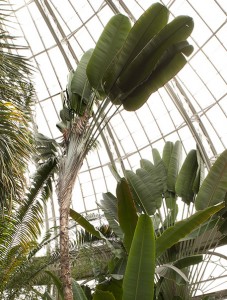 Each morning, I am greeted by the majestic presence of the traveler’s palm (Ravenala madagascariensis) in the Palm Dome of the Enid A. Haupt Conservatory. I planted it myself back in 1996, when the stem was just five feet tall, and I have been watching it mature into this fine specimen ever since—growing taller and stronger daily for the past 18 years. It seems to me that its main goal is to see how quickly its 10-foot-long leaves can touch the glass of the lower dome 60 feet above.
Each morning, I am greeted by the majestic presence of the traveler’s palm (Ravenala madagascariensis) in the Palm Dome of the Enid A. Haupt Conservatory. I planted it myself back in 1996, when the stem was just five feet tall, and I have been watching it mature into this fine specimen ever since—growing taller and stronger daily for the past 18 years. It seems to me that its main goal is to see how quickly its 10-foot-long leaves can touch the glass of the lower dome 60 feet above.
Despite its name, the traveler’s palm is not a palm at all, but instead closely related to the bird of paradise and the banana. Its native home is in the forests of Madagascar, but it can now be found growing in gardens all over the Tropics. It takes the form of an enormous green fan on a tall, robust, grey stem, with its north- and south-pointing leaves providing a makeshift compass for weary travelers. In desperate situations, it also provides much-needed water—not always palatable—that collects in the stem sheaths for those thirsty souls who might happen upon it.